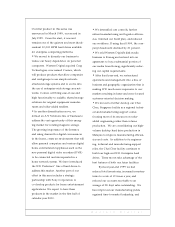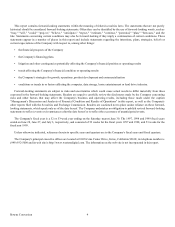Western Digital 1999 Annual Report Download - page 14
Download and view the complete annual report
Please find page 14 of the 1999 Western Digital annual report below. You can navigate through the pages in the report by either clicking on the pages listed below, or by using the keyword search tool below to find specific information within the annual report.Bowne Conversion 9
Constant innovations in research and development are essential to the Company's ability to compete. Hard drive providers are
evaluating or implementing a number of technological innovations designed to further increase hard drive performance and reduce
product costs, including simplifying the electronic architecture by combining the traditional controller, channel, microprocessor and
servo-interface management functions of traditional hard drive microprocessors on a single integrated circuit. Moreover, to
consistently achieve timely introduction and rapid volume production of new products, some hard drive providers are striving to
simplify their product design processes by focusing on creating extendible core technology platforms which utilize common firmware
and mechanical designs and re-use of manufacturing tooling and application specific integrated circuits across various product
generations and product lines.
The Company must expand its product offerings in the enterprise market to include FC-AL interface and other emerging
technologies. The Company's current line of enterprise products consists of SCSI low profile 1.0" high drives with capacity points up
to 18.3 GB. While these products address approximately 70% to 80% of the enterprise market, that percentage is likely to decrease as
demand for FC-AL interface and 10,000 and higher rpm drive products grows. The Company's research and development is crucial to its
success in the enterprise market. There is continuing market pressure to increase the spindle rotational speed and decrease the average
seek time of enterprise products. The Company must build its enterprise infrastructure quickly enough to support this development
schedule. This will involve hiring and retaining qualified engineers at a time when there is a worldwide shortage of such engineers. For
a discussion of our enterprise product development, see Part II, Item 7, under the heading "Risk factors relating to Western Digital
particularly."
Sales and Distribution
The Company sells its products globally to computer manufacturers, distributors, value-added resellers, dealers, system integrators,
retailers and internet-based retailers. Manufacturers typically purchase components such as hard drives and assemble them into the
computer systems they build. Distributors typically sell the Company's drives to small manufacturers, dealers, system integrators and
other resellers.
Manufacturers. Sales to manufacturers accounted for 72%, 69% and 70% of consolidated revenues in 1997, 1998 and 1999,
respectively. The Company's major computer manufacturer customers include Apple Computer, Compaq Computer, Dell Computer,
Fujitsu, Gateway, Hewlett-Packard, IBM, Intel, Micron Electronics and NEC. During 1997, sales to IBM accounted for 13% of revenues.
During 1998 and 1999, sales to Compaq accounted for 14% and 21% of revenues, respectively. The Company believes that its success
depends on its ability to maintain and improve its strong relationships with the leading computer manufacturers. Western Digital,
Quantum, IBM and Seagate have historically had the highest market share with these manufacturers. Over the last two years, Maxtor
Corporation and Fujitsu Limited have introduced new hard drive products and gained market share with leading computer
manufacturers. The increase in the number of qualified suppliers to the leading manufacturers, combined with the growth of the sub-
$1,000 PC market, has placed continuous downward pressure on hard drive prices. This pressure, in turn, has reduced average gross
margins for hard drive suppliers.
The leading PC computer manufacturers have been gaining market share, which has increased their purchasing leverage over
component suppliers. In calendar years 1997 and 1998, the top ten PC computer manufacturers accounted for more than 50% of all PC
shipments and most of the growth in the PC market. In addition, the top four server and workstation computer manufacturers accounted
for almost 50% of server and workstation units shipped in calendar 1998. As a result, maintaining customer satisfaction with these
leading computer manufacturers has become even more critical.
Computer manufacturers typically seek to qualify up to three or four providers for each generation of hard drives. Once a computer
manufacturer has chosen its qualified hard drive vendors for a given product, it generally will purchase hard drives from those vendors
for the life of that product. To achieve consistent success with computer manufacturers' qualifications, a hard drive supplier must be an
early provider of next generation hard drives featuring leading technology and high capacity per disk. Suppliers must quickly achieve
volume production of high quality and reliable hard drives. To quickly achieve high volume production, a hard drive supplier must have
access to flexible, high-capacity, high-quality manufacturing capabilities. Factors on which computer manufacturers evaluate their hard
drive suppliers include overall quality, storage capacities, performance characteristics, price, ease of doing business, and the supplier's
long-term financial stability.
The business models of computer manufacturers are in the process of changing, and these changes have impacted and will
continue to impact Western Digital's sales, inventory and distribution patterns. The forecast-driven, long-production-run logistics
























